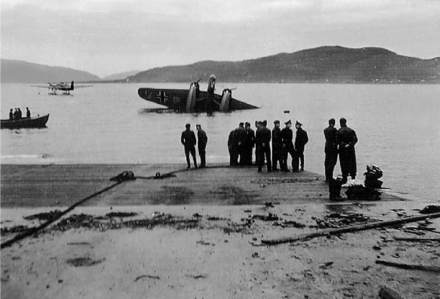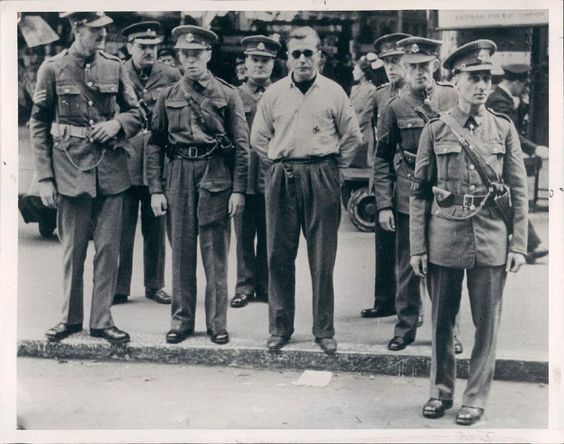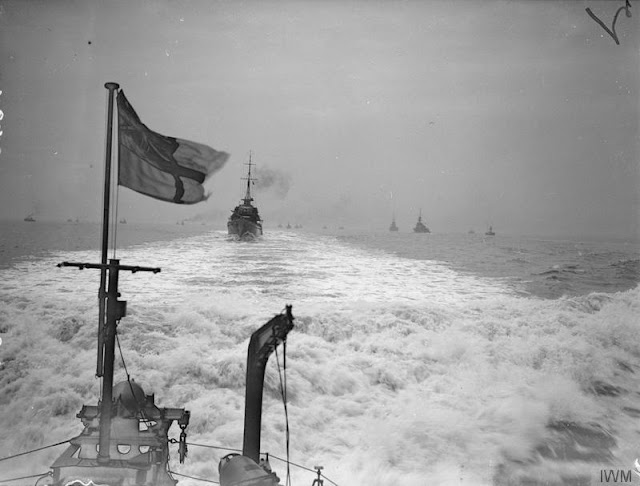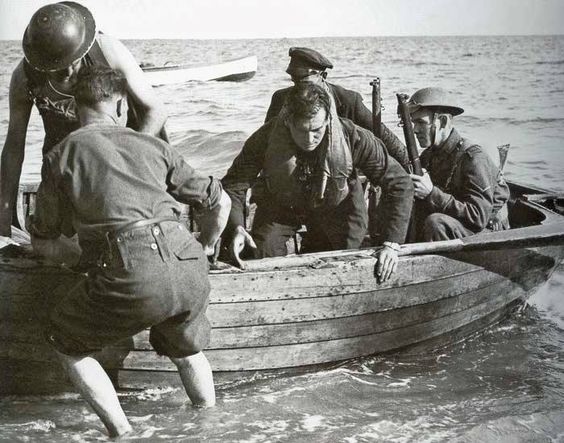Monday 26 August 1940
 |
| An RAF Supermarine Walrus attacks Skattøra airport at Tromsø, causing the damage shown. |
A little before noon, the Luftwaffe sends over more than 100 planes toward Kent. RAF Fighter Command sends up No. 616 Squadron, but they get a late start and the Bf 109s have the altitude advantage. The British lose 7 Spitfires quickly, with two pilot deaths. Kommodore Werner Mölders of Stab./JG 51 gets his 27th victory, while Hauptmann Josef Fözö of 4./JG 51 downs two Spitfires near Dover.
Fighter Command quickly gets more squadrons up from No. 11 Group. RAF No. 264 Squadron takes on some bombers, but its Defiants are no match for the escorting Bf 109s. Three of the Defiants go down quickly, but the others shoot down 6 of the Dornier Do 17s and a Bf 109 before also being shot down. Many of the Dorniers release their bombs prematurely over Dover and Folkestone, while some bomb RAF Kenley and Biggin Hill.
Around 13:00, another formation comes across from the Lille area. This time Fighter Command is more on the ball and gets 10 squadrons in the air over the Thames estuary. RAF No. 310 Squadron (Czech) takes on the escorts first, and is joined No. 56 Squadron. The bombers continue on to Debden, but the mass of RAF fighters gradually grows due to patient tactics by No. 10 Group Air Marshal Keith Park. This sends most of the bombers running for home. About half a dozen Dorniers get through to Debden and destroy many facilities.
Another attack in the afternoon targets Portsmouth and Southampton. This large force of 150 planes including 50 Heinkel He 111s approaches near the Isle of Wight and Fighter Command once again gets a late jump on them. The weather helps the bombers evade many of the RAF fighters, but gathering clouds induce many to return to base after jettisoning their bombs in the water. Portsmouth receives some damage, including the harbor facilities, Fort Cumberland and the Hilsea gas works.
During this attack, a bomb hits destroyer HMS Acheron, killing two men and blowing her stern off. Another destroyer moored next to the Acheron, HMS Bulldog, is damaged and its commander J.P. Wisden seriously wounded (he dies a few days later). A French torpedo boat, the Flore, and command ship HMS Vernon also receive damage. Hauptmann Hans-Karl Mayer of I,/JG 53 downs two Spitfires, but one of his fellow pilots crashes and is killed.
The British continue their attacks on search and rescue planes when they shoot down a Heinkel He 59 south of the Isle of Wight. The British justify these apparent war crimes by claiming that the Heinkels are actually performing covert reconnaissance.
Apparently due to navigational errors, Luftwaffe planes bomb Campile, County Wexford on the west coast of Ireland, 150 miles south of Northern Ireland. There are 3 female deaths. The Irish issue a diplomatic protest.
The Royal Canadian squadron. No. 1, has its first taste of battle and loses one man killed.
The RAF bombs several airfields in the Netherlands during the day.
RAF Bomber Command avoids Berlin during the night after the raid of the 25th and hits Leipzig, Leuna, Hanover, Nordhausen in Germany and Turin and Milan in Italy. The Luftwaffe raids Plymouth, Coventry, and Birmingham.
For the day, the score is higher than in recent days due to the large formations employed. The score usually given is that the Luftwaffe loses about 30-45 planes and the RAF 25-35, with the RAF losing about 10 fewer planes. The heavy Luftwaffe losses induce Hugo Sperrle's Luftflotte 3 to suspend large daylight raids for a while despite the fact that the British are suffering almost equally.
 |
| On 26 August 1940, British guard downed Luftwaffe airman. |
Luftwaffe Ju 88 bombers from KG 30 spot two ships traveling near each other off Fraserburgh, Scotland, and attack. These ships have separated from Convoy HX 65A. The bombers launch aerial torpedoes and seriously damage freighter 5027 ton Cape York traveling in Convoy HX 65A. The crew abandons ship and it sinks while under tow on the 27th.
The bombers also damage 11,445-ton British passenger/refrigerated ship Remuera nearby. Heinkel He 115 seaplanes of KüFlGr 506 then torpedo and sink it. All 94 onboard survive. The bombers also damage the British freighter City of Hankow and Greek freighter Nellie.
Italian submarine Dandolo, operating off the Canary Islands, torpedoes and sinks 5187-ton British freighter Livingston Court. There are 20 survivors, 19 crew perish (accounts vary).
Norwegian local ship Arild hits a mine and sinks off Steinestø, Hordaland, Norway. Everyone survives.
Norwegian trawler 127-ton Avield and 833 ton local ship Odda (both in German service) hit mines and sink in the North Sea.
German 127 ton freighter Lisbeth Cords hits a mine and sinks in the Bay of Kiel.
Operation Menace against Dakar is set in motion when Convoy MS departs from Gibraltar.
Convoy FN 263 departs from Southend, Convoy MT 151 departs from Methil, Convoy FS 263 departs from the Tyne, Convoy SL 45 departs from Freetown.
British corvette HMS Fleur de Lys (K 122) is commissioned.
A Short Sunderland flying boat conducts reconnaissance over the Aegean during the night and suffers mechanical issues, forcing it to land near Kythera. The Greeks intern the crew.
Battle of the Indian Ocean: German raider Pinguin (Ernst Felix Krüder) captures Norwegian tanker Filefjell 200 miles south of Madagascar. The tanker has 10,405 tons of gasoline, 643 tons of diesel, and 144 tons of fuel oil.
German Military: The Wehrmacht, under Hitler's orders, transfers a dozen divisions, including two armored formations, to Poland. This is a pretty clear signal that he is giving up the idea of Operation Sea Lion. The troop transfer is camouflaged as normal troop movements so as to avoid any Soviet questions - of which there are none. This the first large troop movement related to Operation Barbarossa.
German/Palestinian Relations: Haj Amin, the Grand Mufti of Jerusalem, says that he desires better diplomatic relations with Germany.
US/Canadian Relations: A new Permanent Joint Board on Defense has its first meeting in Ottawa. The American delegation is led by Fiorello H. LaGuardia, the President of the U.S. Conference of Mayors. This is the product of the 18 August 1940 meeting of President Roosevelt and Canadian Prime Minister Mackenzie King.
Free France: Governor Felix Eboue of Chad in French Equatorial Africa throws its lot in with the Free French, declaring war on Italy and Germany. This is a major success for "Captain Leclerc."
 |
| British destroyers heading to sea for an all-night exercise. Taken from HMS Jackal, 26 August 1940. © IWM (A 340). |
August 1, 1940: Two RN Subs Lost
August 2, 1940: Operation Hurry
August 3, 1940: Italians Attack British Somaliland
August 4, 1940: Dueling Legends in the US
August 5, 1940: First Plan for Barbarossa
August 6, 1940: Wipe Out The RAF
August 7, 1940: Burning Oil Plants
August 8, 1940: True Start of Battle of Britain
August 9, 1940: Aufbau Ost
August 10, 1940: Romania Clamps Down On Jews
August 11, 1940: Huge Aerial Losses
August 12, 1940: Attacks on Radar
August 13, 1940: Adler Tag
August 14, 1940: Sir Henry's Mission
August 15, 1940: Luftwaffe's Black Thursday
August 16, 1940: Wolfpack Time
August 17, 1940: Blockade of Britain
August 18, 1940: The Hardest Day
August 19, 1940: Enter The Zero
August 20, 1940: So Much Owed By So Many
August 21, 1940: Anglo Saxon Incident
August 22, 1940: Hellfire Corner
August 23, 1940: Seaplanes Attack
August 24, 1940: Slippery Slope
August 25, 1940: RAF Bombs Berlin
August 26, 1940: Troops Moved for Barbarossa
August 27, 1940: Air Base in Iceland
August 28, 1940: Call Me Meyer
August 29, 1940: Schepke's Big Day
August 30, 1940: RAF's Bad Day
August 31, 1940: Texel Disaster
2020


Hi James
ReplyDeleteMackenzie King was not the Canadian Governor General but the Prime minister. Alexander Cambridge, 1st Earl of Athlone, was Governor General of Canada